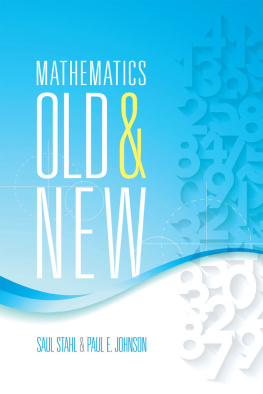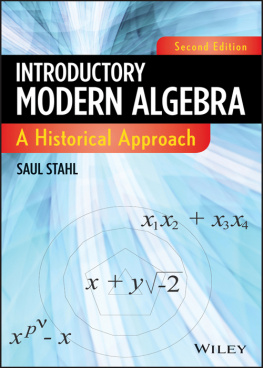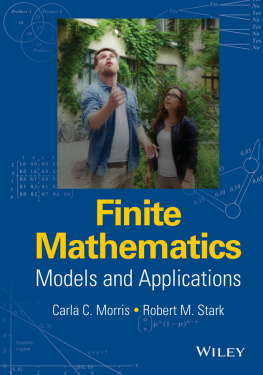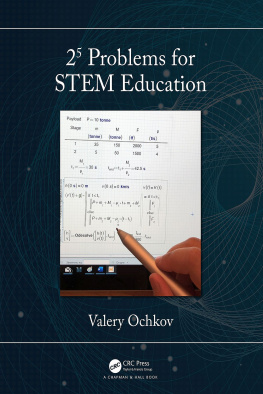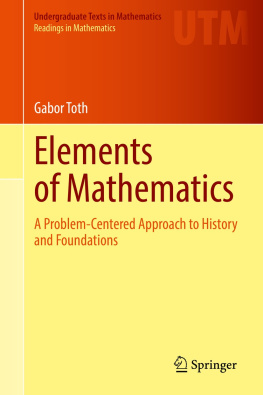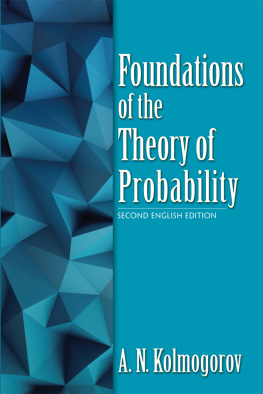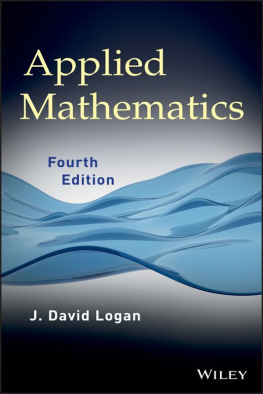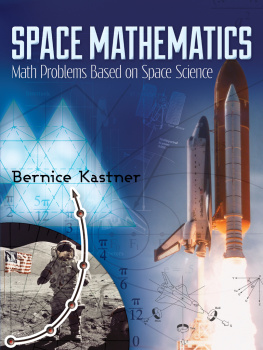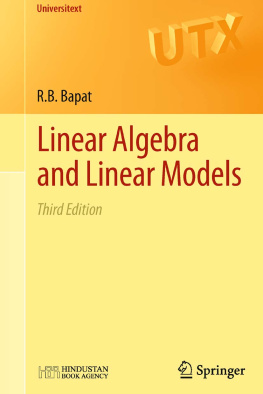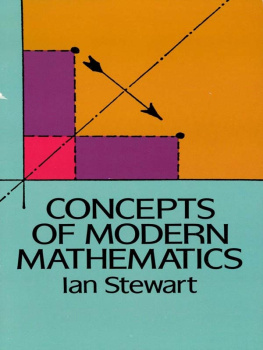MATHEMATICS
OLD & NEW
MATHEMATICS
OLD & NEW
SAUL STAHL & PAUL E. JOHNSON
DOVER PUBLICATIONS, INC.
MINEOLA, NEW YORK
The authors are indebted to their colleagues James Church and Ben Cobb for several informative discussions regarding probability and statistics. They also acknowledge several helpful comments by Mark Huneke, Jennifer Wagner, and the books anonymous reviewers.
is a condensation of portions of Saul Stahls A Gentle Introduction to Game Theory, American Mathematical Society, Mathematical World Volume 13, Copyright 1991, Providence, Rhode Island. The authors are grateful to the Society for its generous permission to include these selections here.
The games described in are reprinted from J. D. Williamss The Complete Strategyst, Dover Publications, Inc., Mineola, New York, 1986, with the permission of the RAND Corporation.
Copyright
Copyright 2007, 2017 by Saul Stahl and Paul E. Johnson
All rights reserved.
Bibliographical Note
Mathematics Old and New, first published by Dover Publications. Inc., in 2017, is a revised and updated version of Understanding Modern Mathematics, originally published in 2007 by Jones and Bartlett Publishers. Sudbury, Massachusetts.
International Standard Book Number
ISBN-13: 978-0-486-80738-6
ISBN-10: 0-486-80738-X
Manufactured in the United States by LSC Communications
80738X012017
www.doverpublications.com
Contents
Preface
This book is aimed at the popular Topics in Mathematics course that is a requirement for the B.A. degree in many universities. This course has no prerequisites above and beyond a minimal amount of high school algebra and is meant to better acquaint the students with mathematics through an exposure to its applications and an exposition of some of its culture.
All the textbooks written for this course have adopted the survey approach and touch many topics lightly. We, however, feel that the courses goals can be best accomplished by focusing on a few important topics and explaining both their significance and evolution in some depth. This calls for locating good mathematical ideas that are presentable at the level of the class, convincing the students of their value, and allowing enough time to permit the concepts to take root in the students minds through drill and development.
In our opinion, it is a serious pedagogical mistake to teach easy applications just because they show how mathematics can be used in an applied context. The superficiality of the mathematics will not escape the students and they will lose respect for the subject matter. With the respect will also go their willingness to learn. For this reason we have concentrated on a few topics whose centrality to mathematics is well known: probability, statistics, game theory, linear programming, and symmetry. The topic of social choice was added to these because its paradoxes and surprises make it a favorite with students.
While these topics have been expounded in many texts, our development of most of them is unique:
Probability and statistics: The exposition is focused on the normal curve. The evolution of this curve is set forth in detail together with explanations of the scientific needs that motivated the invention of some of the standard statistical procedures. This amounts to a comprehensible explanation of how and why the normal curve came to occupy the eminent position it does in our society a tale in which Columbus, Galileo, the French Revolution, Gauss, and the Average Man all play their parts.
Voting systems: This chapter explores voting mechanisms that can be used to decide among a discrete set of alternatives. Although individual voters may be transitive and logical in their behavior, the aggregation of their opinions through a voting procedure can often produce problematic outcomes. The chapter includes a wide range of voting procedures, including the long-standing ones like plurality, majority, and rank-order voting, as well as some very recent proposals intended to address the weaknesses of the older methods. Several criteria for evaluation of voting procedures are considered.
Game theory: Enough game theory is taught so that the students gain an appreciation of the Nash equilibrium, a concept for which the economists voted to award the 1994 Nobel Prize to the mathematician John Nash. The popularity of the movie A Beautiful Mind makes this subject even more topical. Non-trivial applications to economics, population biology, anthropology, political science and other social situations are discussed.
Linear programming: The exposition is conventional. We included this material only because of its popularity amongst the instructors of this course and because of its importance as a tool of applied mathematics.
Symmetry: Contrary to common practice in books for this audience, we have added three-dimensional symmetry to the standard two-dimensional material. This makes possible visual/calculational problems that have just the right level of difficulty. It also provides a context for recounting to them the mysterious tale of Monstrous Moonshine the story of the classification of the finite simple groups, MONSTER, and the mysterious connections with non-Euclidean geometry.
Map colorings: The study of map colorings passed on two surprisingly difficult problems. While both were solved a century later, both could be considered genuinely difficult problems since their proofs were long and subsequently no shorter proofs have emerged. The Four Color surely holds the distinction of producing more false proofs than any other. However, we have chosen to expound on the resolution of the Ringel-Youngs Theorem for no other reason than the exotic nature of its proof.
The evolution of the normal distribution: It is arguable that the normal distribution, otherwise known as the bell-shaped curve, has as many users as do Newtons Three Laws. An examination of its history reveals much about the way scientists go about their business.
Chapter 1
Probability
Animal astragali bones used for gambling have been found in graves that are thousands of years old. These archaeological artifacts indicate that the interest in the likelihood of events goes back to antiquity. Probability, which is the quantification of the informal notion of likelihood, dates back only as far as the Italian Renaissance. Subjective and objective notions of probability are discussed and some formal properties of the latter are stated. These are applied to the derivation of the probabilities of compound events. The normal curve is introduced as a computational aid.
1.1The Quantification of Likelihood
It is often said that the only certain things in life are death and taxes. Most other aspects of life and the universe have some uncertainty attached to them: although the sun is practically certain to rise tomorrow, it is known that some day it will fail to do so; on the next July Fourth the temperature in Kansas City may top 85F; the Dow Jones index may rise tomorrow; a woman may be elected as president in the next U.S. presidential election. All readers will agree that these events have been listed in decreasing order of likelihood and this consensus indicates that the ephemeral quality of likelihood should in fact be quantifiable. Such quantifications were first phrased in terms of ones willingness to risk stakes in betting on such uncertain events, i.e., as odds. This, however, was too subjective a procedure for scientific purposes and eventually an objective set of rules were laid down which serve as an objective definition of probability.

